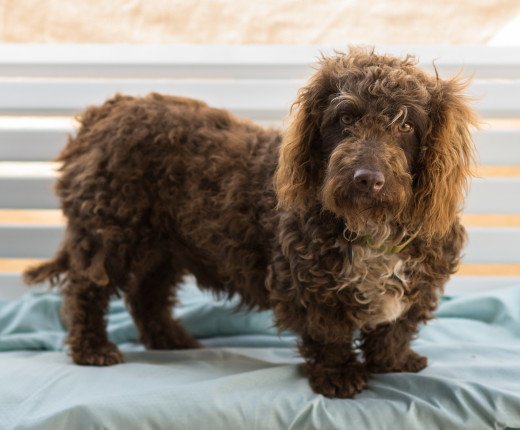Bassetoodle


About Bassetoodle
The Bassetoodle is also referred to as the Bastoodle, Bassetpoo, and Bassetdoodle. These little dogs are a lot of fun, but their curiosity can get the better of them and cause them to wander off, so they should be supervised while they are outside.
To learn if the adorable Bassetoodle would be the right pet for your family, keep reading for a few helpful facts.
The Bassetoodle is a cross between a purebred Basset Hound and Poodle.
The Bassetoodle is a designer crossbreed from the United States.
The Bassetoodle is a cross between a purebred Basset Hound and Poodle.
Choose a high quality canine-appropriate diet for your Bassetoodle. If you are feeding your dog dry food, you can provide him with anywhere from ¾ cup to 1½ cups of food per day, divided into at least two meals.
These dogs are likely to overeat and gain excess weight, so feed the correct portion according to your dog’s size and energy requirements. If you are going to also provide canned dog food and treats, adjust the amount of dry food accordingly to help prevent unwanted weight gain.
The Bassetoodle is a breed that is intelligent and willing to please.
The Bassetoodle is a breed that is intelligent and willing to please, so these dogs will be pretty easy to train. However, you need to establish yourself as the pack leader, as these little dogs can also be stubborn. Be firm, but kind, as well as consistent in your approach. Use positive reinforcement training techniques and a reward system for the best results.
These dogs generally perform well when given the opportunity to try agility training and obedience training. The sooner you begin training your dog, the better the results will be, especially when it comes to keeping barking to a minimum and preventing your dog from jumping on people or exhibiting destructive behaviors.
A small-sized breed, the Bassetoodle weighs between 20 and 30 pounds.
The Bassetoodle isn’t just a good looking canine, it is also a dog that makes a fantastic family pet. These dogs are calm and thoroughly enjoy being around people. They will not hesitate to show their affection and dedication to their human family, and they even get along well with children and other pets. They thrive on companionship and should not be left alone for long periods of time.
You can expect that a Bassetoodle will exude joy and be outgoing. However, these dogs can also be mischievous and stubborn. Nevertheless, their positive attributes outweigh their sometimes negative behaviors. They are silly and a lot of fun to be around, and they are faithful pets who enjoy exploring the great outdoors, riding in cars, and being groomed.
If you are in search of a watchdog, a Bassetoodle may be a good choice, as these dogs will let you know if they see anything suspicious in their environment. Rather than barking, though, they are likely to howl.
When your dog is playing outside, keep an eye on him, as he may wander off if he ends up finding a scent or his curiosity is piqued by something.
As with all other hybrid canine breeds, the Bassetoodle may be susceptible to the diseases that afflict its parent breeds. However, there is no guarantee that your dog will ever come down with any of those ailments.
Some of the conditions that commonly affect the Poodle and Basset Hound include epilepsy, joint dysplasia, eye problems, ear infections, obesity, allergies, and bloat.
The Bassetoodle has an average lifespan of 12 to 15 years.
A great way to exercise your Bassetoodle is by simply giving him an opportunity to play, which is something that he will love to do. A trip to the dog park each day, playtime in a safe backyard with a secure fence, and a walk or jog are all good examples of ideal ways to exercise this breed. You can also provide fun toys that your dog can play with while spending time indoors.
Short exercise sessions are preferred, as these dogs don’t have a lot of energy and they don’t like long activity sessions.
The Bassetoodle isn’t just a good looking canine, it is also a dog that makes a fantastic family pet.
The Bassetoodle is not recognized by the American Kennel Club, as it is considered to be a hybrid breed. However, this breed is recognized by the American Canine Hybrid Club (ACHC), the Designer Breed Registry (DBR), the Designer Dogs Kennel Club (DDKC), the Dog Registry of America, Inc. (DRA), and the International Designer Canine Registry (IDCR).
The Bassetoodle’s medium length coat, which is wiry and thick, can range from curly to straight. It sheds a moderate amount, but frequent brushing, probably around two or three times per week, will be necessary to prevent matting.
You can bathe your Bassetoodle every couple of weeks to be certain that he is clean and to maintain the sheen of his coat. You may also want to hire a professional dog groomer to trim your dog’s fur whenever it gets too long.
Bassetoodle puppies will be tiny and will require tender care to prevent injuries. Start training your puppy from a young age so he’ll learn what behaviors are appropriate, and socialize your puppy so that he’ll be comfortable around a variety of people and animals.
Photo credit: Megan/Flickr

Lisa Selvaggio is a freelance writer and editor, and our resident cats-pert, with certifications in pet nutrition and pet first aid. She enjoys producing content that helps people understand animals better so they can give their pets a safe and happy home.
More by Lisa Selvaggio

























